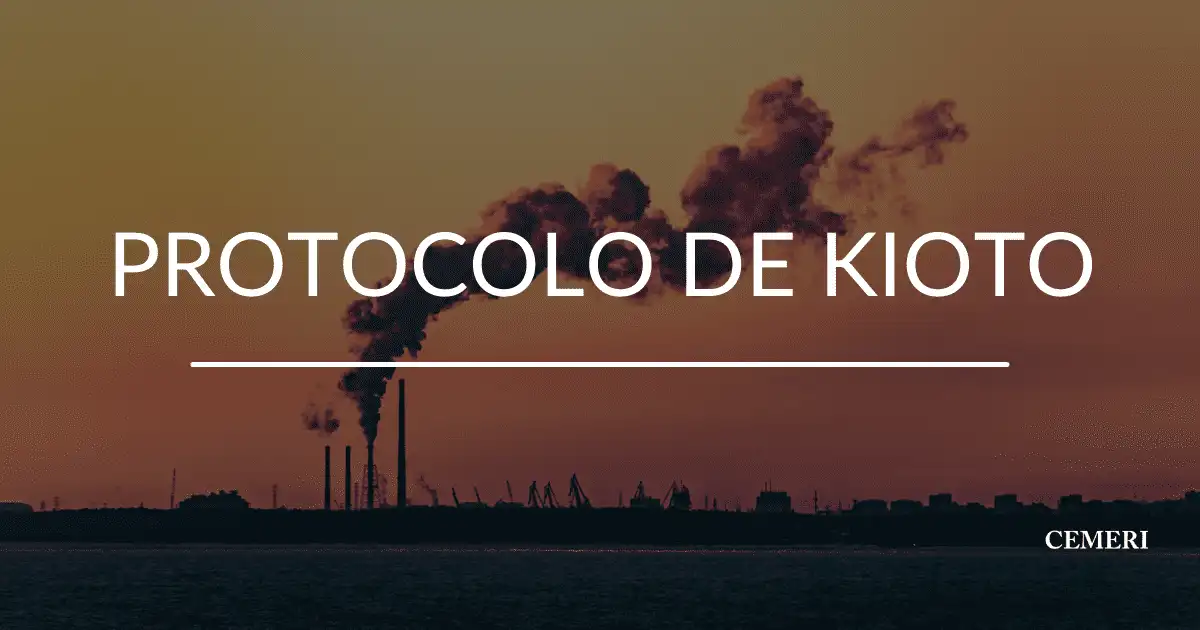Encyclopedia
Luis Salgado
What is the Kyoto protocol?
- This instrument called for the reduction of the emissions of six greenhouse gases in a total of 192 countries.

The Kyoto Protocol (also Kyoto) or Kyoto Protocol to the United Nations Framework Convention on Climate Change, is an international treaty that aimed to reduce the emission of six greenhouse gases (GHGs) that contribute to global warming. .
The protocol was adopted in Kyoto, Japan, on December 11, 1997 and entered into force on February 16, 2005. This instrument called for the reduction of six greenhouse gas emissions in a total of 192 countries, including industrialized countries and those members of the European Union, to 5.2% below 1990 levels during the 2008-2012 commitment period, which would represent about 29% of total world emissions. However, this period was extended until 2020.
The protocol was widely hailed as the most important environmental treaty ever negotiated, even more so than the Montreal Protocol, though some critics questioned its effectiveness. Countries that ratified the Kyoto Protocol were assigned carbon emission ceilings for specific periods and engaged in carbon credit trading. The system worked in such a way that if a country emitted more than its allocated limit, then it would receive a lower emission limit in the following period in order to offset the excess emissions.
December 1, 1997. Third Session of the Conference of the Parties to the United Nations Framework Convention on Climate Change (UNFCCC – COP3), Kyoto, Japan. Plenary meeting in the main hall of the Kyoto International Conference Center.
Photo: Audiovisual Library of International Law
What are the greenhouse gases that contribute to climate change and what are their effects?
Greenhouse gases, such as carbon dioxide (CO2), methane (CH4), nitrous oxide (N2O), perfluorocarbons (PFCs), hydrofluorocarbons (HFCs), and sulfur hexafluoride (SF6), affect the energy balance of the atmosphere in ways that are expected to lead to an overall increase in global average temperature, known as global warming.
According to the Intergovernmental Panel on Climate Change (IPCC), established by the United Nations Environment Program (UNEP) and the World Meteorological Organization (WMO) in 1988, the long-term effects of global warming would include a general rise in sea levels around the world, which would result in the inundation of low-lying coastal areas and the possible disappearance of some island states; melting of Arctic glaciers, sea ice and permafrost; an increase in the number of extreme weather-related events, such as hurricanes, floods, fires, and droughts, and changes in their distribution; and an increased risk of extinction for 20 to 30 percent of all plant and animal species.
The effects of global warming are already being witnessed in the world.
Photo: Matt Palmer
Developed vs. Developing Countries
Recognizing that developed countries are primarily responsible for current levels of greenhouse gas (GHG) emissions as a result of more than 150 years of unremitting industrial activity, the Kyoto Protocol placed a heavier burden on them. 37 industrialized countries (plus the European Union (EU) were given a mandate to reduce their greenhouse gas emissions, while developing countries were asked to voluntarily comply; more than 100 developing countries, including China and India, they were exempted from the treaty.
The Protocol separated countries into two groups:
- Annex I, which contained the developed countries
- Non-Annex I (also known as Annex B), which contained developing countries.
Emission limits were set only in Annex I countries. Non-Annex I countries could invest in national projects or programs to reduce emissions in their countries. For these projects, developing countries obtained carbon credits that they could trade or sell to developed countries, allowing developing countries a higher level of carbon emissions caps for that period. This allowed developed countries to continue emitting GHGs.
The Protocol established a monitoring, review and verification system, as well as a compliance system to ensure transparency and hold all parties accountable. Emissions from all countries had to be monitored and accurate records of transactions maintained through registry systems.
Kyoto Mechanisms
The Protocol established market mechanisms based on the trading of emission permits. It allowed countries an additional means to meet their targets through three market-based mechanisms: International Emissions Trading, Clean Development Mechanism (CDM) and Joint Implementation (JI).
The mechanisms promoted GHG mitigation in the most cost-effective manner. The idea was that as long as pollution is removed from the atmosphere, it doesn't matter where it is reduced, which spurred green investment in developing countries and included the private sector to develop cleaner infrastructure and systems instead of older, dirtier technology .
An Adaptation Fund was established to finance adaptation projects and programs in developing countries that are Parties to the Protocol. In the first commitment period, the Fund was financed primarily from a portion of the proceeds from CDM project activities. For the second commitment period, international emissions trading and joint implementation would provide the Fund with a 2% share of revenue.
The International Emissions Trading mechanism allowed countries that have emission units to spare (emissions allowed but not “used”) to sell this excess capacity to countries that are above their targets.
The Clean Development Mechanism allowed a country with a commitment to reduce or limit emissions under the Kyoto Protocol (Part of Non-Annex I) to implement a project to reduce emissions in developing countries. Such projects can earn salable Certified Emission Reduction (CER) credits, each equivalent to one ton of carbon dioxide (CO2), which can be counted toward meeting Kyoto protocol targets.
Finally, the Joint Implementation mechanism allowed a country with a commitment to reduce or limit emissions under the Kyoto Protocol (Part of Annex B) to obtain emission reduction units (UREs) from an emission reduction or removal project in another Annex B Party, each equivalent to one tonne of CO2, which can be counted towards its Kyoto target.
The Doha Amendment
After the first commitment period of the Kyoto Protocol ended in December 2012, the parties to the Protocol met in Doha, Qatar, to discuss an amendment to the original Kyoto agreement. The Doha Amendment added new targets for the second commitment period, 2012-2020. While the first commitment period aimed to reduce GHGs by 5%, the second amendment committed to reducing GHG emissions by at least 18% below 1990 levels. This was short-lived as by 2015, all UNFCCC participants signed another pact, the Paris Climate Agreement (also known as the Paris Agreement), which effectively replaced the Kyoto Protocol.
Obstacles
In 2005, many countries, including those in the EU, planned to meet or exceed their targets under the agreement by 2011. Others, such as the United States and China, the world's biggest emitters, produced enough greenhouse gases to mitigate any of the progress made by countries that met their targets. In fact, there was an increase of around 40% in global emissions between 1990 and 2009.
China is the largest emitter of greenhouse gases.
Photo: REUTERS/China Daily
Why didn't the United States sign the Kyoto Protocol?
The US left the agreement in 2001, calling the treaty unfair because it forced developed countries to cut emissions and felt that doing so would hamper the US economy.
The talks have been clouded by politics, money, a lack of leadership and a lack of consensus. GHG emissions continue to increase and countries are not addressing them fast enough or have managed to create binding reduction actions despite the entry into force of 2 protocols already.
Important dates of the Kyoto Protocol
December 11, 1997 – The UNFCCC Conference of the Parties takes place in Kyoto, Japan. Nearly 200 nations attend and adopt the first international treaty on management and reduction of greenhouse gases.
November 2, 1998 - In Buenos Aires, 160 countries meet to work out the details of the protocol and create the "Buenos Aires Action Plan."
July 23, 2001 - Negotiators from 178 countries meet in Germany and agree to adopt the protocol, without the participation of the United States.
November 10, 2001 - Representatives from 160 countries meet in Marrakech, Morocco, to work out the details of the protocol.
November 18, 2004 – The Russian Federation ratifies the protocol.
February 16, 2005 – The Kyoto Protocol entered into force.
December 12, 2011 – Canada withdraws from the Kyoto Protocol, saying its targets are not achievable because the United States and China never agreed to it, and says a new pact is needed to address emissions.
December 2012 – The Kyoto Protocol is extended until 2020 during a conference in Doha, Qatar.
June 23, 2013 – Afghanistan adopts the Kyoto Protocol, becoming the 192nd signatory.
2015 – At the COP21 summit, held in Paris, all UNFCCC participants sign the Paris Agreement which effectively replaces the Kyoto Protocol. The parties agree to mitigate climate change to "well below" 2 degrees, and below 1.5 degrees above pre-industrial levels if possible.
The Paris Climate Agreement
After a series of disagreement-filled conferences, almost all nations (190 states and the EU) adopted it in 2015 to address the negative effects of the climate crisis. The agreement covers around 97% of global greenhouse gas emissions. The main GHG emitting countries made commitments to reduce their emissions and strengthen these commitments over time. It was arguably the first time that most of the world agreed to pursue a common cause.
One of the main directives of the agreement is to reduce greenhouse gas emissions to limit global temperature rise this century to 2 degrees Celsius above pre-industrial levels, while taking steps to limit it to 1.5 degrees Celsius. It also provides a way for developed nations to help developing nations and creates a framework for monitoring and reporting countries' climate targets in a transparent manner. Unfortunately, countries are not on track to achieve the Paris Agreement: a UNFCCC report indicated that nations must redouble their climate efforts if they are to meet the Paris Agreement target of limiting global temperature rise to 2°C. , ideally 1.5 °C, by 2100.
Sources
SIN FUENTES

